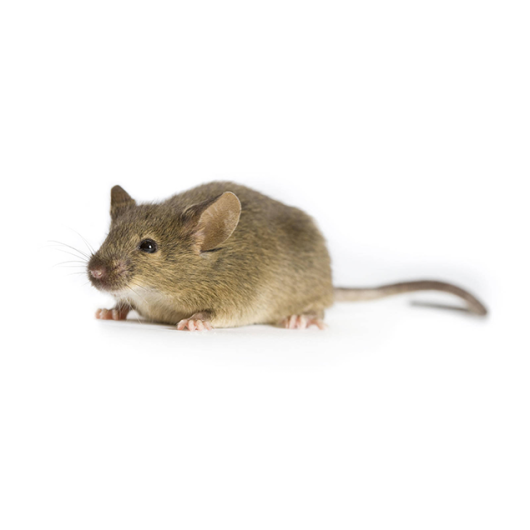
C3H Heston, C3 mouse, C3H/HeJ
C3H/HeJ mice, commonly called C3H, are used as a general purpose strain in a wide variety of research areas including cancer, infectious disease, sensorineural, and cardiovascular biology research. A spontaneous mutation in Tlr4 occurred in C3H/HeJ at the lipopolysaccharide response locus (mutation in toll-like receptor 4 gene, Tlr4Lps-d) making C3H/HeJ mice more resistant to endotoxin. C3H/HeJ mice are highly susceptible to infection by Gram-negative bacteria such as Salmonella enterica. The C3H substrains at The Jackson Laboratory are homozygous for the retinal degeneration 1 mutation (Pde6brd1), causing blindness by weaning age.
Nomenclature: C3H/HeJ
Type: Inbred
Important Note: This strain does not carry mouse mammary tumor virus (MMTV). This strain is homozygous for retinal degeneration allele Pde6brd1, the defective lipopolysaccharide response allele Tlr4Lps-d, and for a chromosomal inversion on Chromosome 6. A sighted alternative is Stock No. 003648, C3Sn.BLiA-Pde6b+/DnJ.
Origin: The C3H parent strain was developed by LC Strong in 1920 from a cross of a Bagg albino female with a DBA male followed by selection for high incidence of mammary tumors (L.C. Strong, 1935). This high incidence resulted from exogenous mouse mammary tumor virus (MMTV) transmitted through the mother's milk. The Jackson Laboratory maintains four C3H substrains, C3H/HeJ (Stock No. 000659), C3H/HeOuJ (Stock No. 000635), C3HeB/FeJ (Stock No. 000658) and C3H/HeSnJ (Stock No. 000661) that are now free of exogenous MMTV. C3H/HeJ and C3H/HeOuJ mice previously carried MMTV but were rederived in 1999 during planned efforts to increase the overall health status of the mice and the virus was not reintroduced. C3H/HeJ and C3H/HeOuJ substrains were separated in 1952 and are genetically very similar. However, a spontaneous mutation occurred in C3H/HeJ sometime between 1960 and 1968 at lipopolysaccharide response locus (mutation in toll-like receptor 4 gene, Tlr4lps) making C3H/HeJ mice endotoxin resistant while the other three C3H strains are endotoxin sensitive.
Detailed description: C3H/HeJ mice are used as a general purpose strain in a wide variety of research areas including cancer, immunology and inflammation, sensorineural, and cardiovascular biology. C3H/HeJ mice and all other Jackson substrains are homozygous for the retinal degeneration 1 mutation (Pde6brd1), which causes blindness by weaning age, but lack the nob5 allele of Gpr179 (Chang, 2015). White belly spots, ranging in phenotype from a few white hairs to a defined spot are common in C3H/HeJ mice. There is also a high incidence of hepatomas in C3H mice (reportedly 72-91% in males at 14 months, 59% in virgin females, 30-38% in breeding females). Despite the lack of exogenous mouse mammary tumor virus (MMTV), virgin and breeding females may still develop some mammary tumors later in life. C3H/HeJ mice, fed an atherogenic diet (1.25% cholesterol, 0.5% cholic acid and 15% fat), fail to develop atherosclerotic aortic lesions in contrast to several highly susceptible strains of mice (e.g. C57BL/6J, Stock No. 000664; C57L/J, Stock No. 000668, C57BR/cdJ, Stock No. 000667, and SM/J, Stock No. 000687). C3H/HeJ mice spontaneously develop alopecia areata (AA) at a reported incidence of approximately 0.25% by 5 months of age. In older mice (12-18 months old), incidences as high as approximately 20% are reported. Females as young as 3-5 months can develop AA, but onset typically is delayed until after 6 months in males. Alopecia areata can be surgically-induced by grafting a small piece of skin from an older, donor animal with AA onto a younger, isogenic C3H/HeJ recipient.
A spontaneous mutation occurred in C3H/HeJ at the lipopolysaccharide response locus (later identified as a mutation in the toll-like receptor 4 gene, Tlr4Lps-d) making C3H/HeJ mice endotoxin resistant. C3H/HeJ (Tlr4Lps-d) mice are highly susceptible to infection by Gram-negative bacteria such as Salmonella enterica. Mice infected with Salmonella exhibit delayed chemokine production, impaired nitric oxide generation and attenuated cellular immune responses. Mortality in infected mice appears to result from enhanced bacterial growth within the liver Kupffer cell network (Vazquez-Torres et al., 2004). The C3H/HeJ substrain is homozygous for an inversion on Chromosome 6 (symbol: In(6)1J). The inversion covers 20% of Chromosome 6 between D6Mit124 (~30.3 cM) and D6Mit150 (~51.0 cM), but results in no reported phenotype. Results from screening other C3H substrains and cryopreserved stock from C3H/HeJ suggest that the mutation arose after 1952. The spontaneous mutation, spike wave discharge 1 (Gria4spkw1), is present in C3H/HeJ, but not C3HeB/FeJ. Mice homozygous for this mutation exhibit a modest incidence of absence seizures. This strain is also homozygous for a hypomorphic allele in Pcnx2, which is caused by an IAP insertion and which dampens the severity of the absence seizure phenotype caused by Gria4spkw1 (Frankel et al., 2014).
JAX™ Stock No: 000659
More information about the strain on JAX website.
Note: Only The Jackson Laboratory and Charles River in Europe and Japan maintain colonies of JAX™ Mice strains which are derived from pedigreed mice from The Jackson Laboratory and are re-infused routinely with pedigreed mice to stabilise the genetic integrity and phenotype of these strains.
JAX™ is a trademark of The Jackson Laboratory registered in the United States. All rights reserved.
Charles River Laboratories is the official distributor of JAX mice in Europe. Click and read more.

